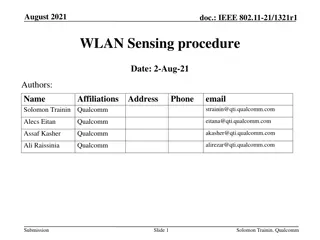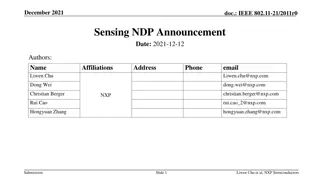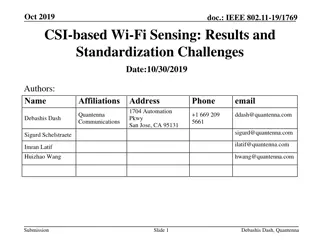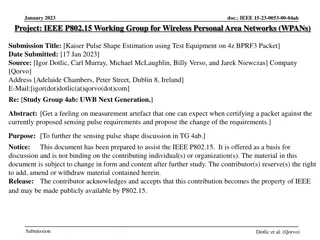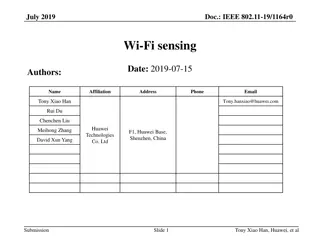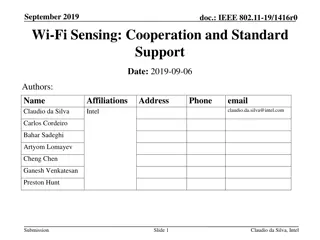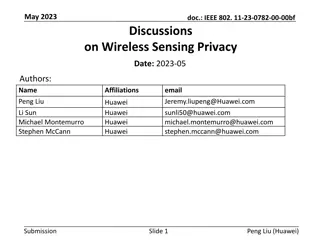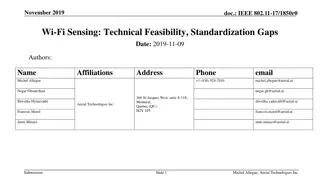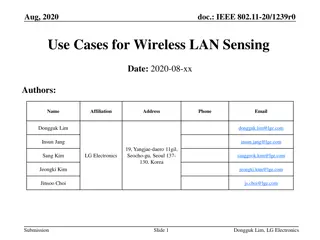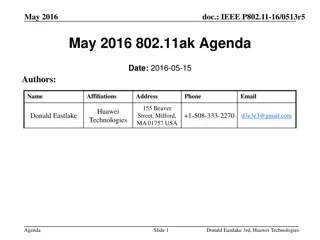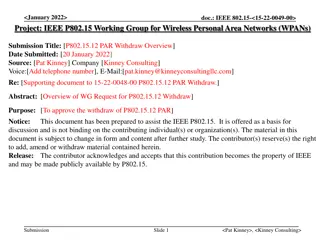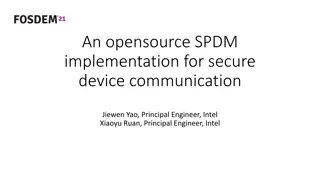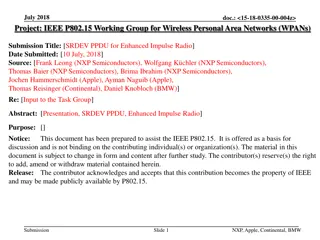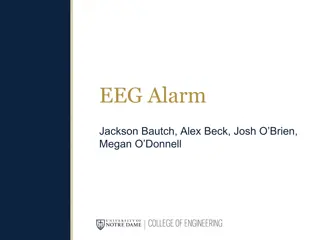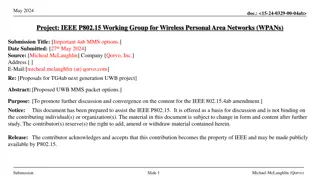IEEE P802.15 WPAN Sensing Device Submission
This submission to the IEEE P802.15 Working Group focuses on the development of a sensing device for Wireless Personal Area Networks (WPANs). The document discusses the integration of Ultra-Wideband (UWB) technology for sensing applications, including presence detection and environment mapping. Key objectives include interference mitigation, coexistence improvement, and enhancing link budget and accuracy for ranging. The proposal emphasizes reusing existing PHY elements and specifying carrier frequencies for sensing. Overall, the submission aims to advance UWB sensing capabilities within the WPAN domain.
Download Presentation

Please find below an Image/Link to download the presentation.
The content on the website is provided AS IS for your information and personal use only. It may not be sold, licensed, or shared on other websites without obtaining consent from the author. Download presentation by click this link. If you encounter any issues during the download, it is possible that the publisher has removed the file from their server.
E N D
Presentation Transcript
March 2022 Project: IEEE P802.15 Working Group for Wireless Personal Area Networks (WPANs) doc.: <15-22-0175-00-04ab> Submission Title: [Sensing Device] Date Submitted: [11 March, 2022] Source: [Dag T. Wisland (Novelda AS), Frank Leong (NXP Semiconductors), Kristian Granhaug, Dries Neirynck, Nikolaj Andersen (Novelda AS), Wolfgang K chler, Riku Pirhonen (NXP Semiconductors)] Re: [Input to the Working Group] Abstract: [Presentation, UWB in 802.15, sensing] Purpose: [] Notice: discussion and is not binding on the contributing individual(s) or organization(s). The material in this document is subject to change in form and content after further study. The contributor(s) reserve(s) the right to add, amend or withdraw material contained herein. Release: The contributor acknowledges and accepts that this contribution becomes the property of IEEE and may be made publicly available by P802.15. This document has been prepared to assist the IEEE P802.15. It is offered as a basis for Submission Slide 1 Wisland (Novelda), Leong (NXP), et al.
January 2022 doc.: <15-22-0175-00-04ab> PAR Objective Safeguards so that the high throughput data use cases will not cause significant disruption to low duty-cycle ranging use cases Interference mitigation techniques to support higher density and higher traffic use cases Other coexistence improvement Backward compatibility with enhanced ranging capable devices (ERDEVs) Improved link budget and/or reduced air-time Additional channels and operating frequencies Improvements to accuracy / precision / reliability and interoperability for high-integrity ranging Reduced complexity and power consumption Hybrid operation with narrowband signaling to assist UWB Enhanced native discovery and connection setup mechanisms Sensing capabilities to support presence detection and environment mapping Low-power low-latency streaming Higher data-rate streaming allowing at least 50 Mbit/s of throughput Support for peer-to-peer, peer-to-multi-peer, and station-to- infrastructure protocols Infrastructure synchronization mechanisms Proposed Solution (how addressed) Re-use of existing PHY elements Specification of carrier frequencies for Sensing Outlining key Sensing PHY and MAC aspects Submission Slide 2 Wisland (Novelda), Leong (NXP), et al.
January 2022 doc.: <15-22-0175-00-04ab> Sensing Device Submission Slide 3 Wisland (Novelda), Leong (NXP), et al.
January 2022 doc.: <15-22-0175-00-04ab> UWB Sensing in 802.15.4ab UWB is positioned to enable large-scale deployment of uniquely high-performant standardized Sensing functionality, when provided as part of a Ranging+Sensing radio concept Address new Sensing-based applications Leverage Sensing to accelerate adoption of UWB technology Define the Sensing Device (SDEV) Specify a conditionally mandatory basic feature set, enabling high-performance UWB Sensing @ ~500 MHz BW Specify SDEV as an extension of ERDEV capabilities SDEVs using ERDEV capabilities are good spectrum citizens Specify options beyond the SDEV to support up to 1.5 GHz BW Support Sensing Networks Distributed Sensing systems Coexistence management Networks using both Multistatic and Monostatic Sensing results Submission Slide 4 Wisland (Novelda), Leong (NXP), et al.
January 2022 doc.: <15-22-0175-00-04ab> UWB Sensing Terminology Align Sensing terminology with IEEE Std 686-2017 Extend with additional (e.g., Monostatic Sensing) terminology where applicable, e.g.: tap, (range) bin, resolution cell Submission Slide 5 Wisland (Novelda), Leong (NXP), et al.
January 2022 doc.: <15-22-0175-00-04ab> UWB Sensing More Terminology Illuminating Signal (from Sensing Transmitter/Initiator) Echo Signal (to Sensing Receiver/Responder): Sensing Processor creates Sensing Result from Sensing Measurement Submission Slide 6 Wisland (Novelda), Leong (NXP), et al.
January 2022 doc.: <15-22-0175-00-04ab> Use of Multiple Antennas per Station Specify periodic (e.g., existing Ipatov) sequences to be used for Sensing as drop-in replacement for STS segments (i.e., support multiple segments separated by gaps) This could support per-segment assignment of (virtual) TX antennas Support multiple spreading factors {1, ..., 128} (i.e., PRFs {499, ..., 4} MHz) Dynamically adjustable per-segment parameters Consider explicit signaling to indicate intention to use a packet for Sensing (e.g., setting a PHR bit) Submission Slide 7 Wisland (Novelda), Leong (NXP), et al.
January 2022 doc.: <15-22-0175-00-04ab> UWB Sensing Pulse Shape (I) Specify a tight bound for Sensing pulse shape fidelity Sensing performance depends more strongly on pulse shape than Ranging performance does Specify the Sensing pulse such that it complies with Ranging requirements Enable mode switching without change of pulse shape Enable Sensing systems piggy-backing on Ranging protocols Submission Slide 8 Wisland (Novelda), Leong (NXP), et al.
January 2022 doc.: <15-22-0175-00-04ab> UWB Sensing Pulse Shape (II) Avoid pre-ringing and post-ringing, strictly time-bound the pulse Approximate a Gaussian pulse shape to be used for Sensing For Sensing, specify a smooth Kaiser window (time-bounded) with L equivalent to 3 chips and = = 10 as reference shape Submission Slide 9 Wisland (Novelda), Leong (NXP), et al.
January 2022 doc.: <15-22-0175-00-04ab> UWB Sensing Carrier Grid Spacing Performing Sensing at multiple carrier frequencies allows to achieve large effective total bandwidth In order to avoid artifacts, some overlap may be desirable Overlap somewhere between 25-75% may be desirable Carrier grid spacing of 124.8 MHz allows to choose between 124.8 MHz (N+1, i.e., ~75% overlap), 249.6 MHz (N+2, i.e., ~50% overlap), and 374.4 MHz (N+3, i.e., ~25% overlap) configurations Submission Slide 10 Wisland (Novelda), Leong (NXP), et al.
January 2022 doc.: <15-22-0175-00-04ab> UWB Sensing CIR Sharing (I) CIR Reports are central to Sensing Networks Frequently transmitted together with the Sensing waveform, therefore representing a high-priority specification item Static IEs and dependent IEs can be specified in a next step Essentially, we propose two types of CIR representation: 1. I/Q Amplitude Pairs 2. Range-Velocity Pairs with optional AoA (Azimuth) and EoA (Elevation) support Support both Multistatic and Monostatic Sensing Measurements Facilitate Distributed/Collaborative/Remote/Proxy Sensing Enable simultaneous tracking of multiple targets Higher sampling rates to facilitate optional Large BW modes Submission Slide 11 Wisland (Novelda), Leong (NXP), et al.
January 2022 doc.: <15-22-0175-00-04ab> UWB Sensing CIR Sharing (II) Dedicated Information Element for CIR sharing Facilitate centralized processing (i.e., support the use of dumb edge nodes) Support transmission of selected ranges of CIR taps (referred to 0 meters) Support complex CIR tap sizes of 2*{8,12,16,24} bits CIR tap I&Q amplitudes encoded in linear scale, with sampling rate ({1,2,4,8} times the chip rate), reference level and tap size (I&Q always of same size) to be set via dedicated IE or OOB means Structure / Order of Transmission: Main Header Range Header 1 Range Body 1 Range Header 2 Range Body 2 ... Range Header N Range Body N Submission Slide 12 Wisland (Novelda), Leong (NXP), et al.
January 2022 doc.: <15-22-0175-00-04ab> UWB Sensing CIR Sharing (III) Main Header (transmitted 1x) Field Name Field Length (Bits) Description Compression 1 Set when using DEFLATE (i.e., Zip) compression of fields beyond the first octet Reserved 7 Reserved Number of Ranges 8 Number of CIR ranges transmitted Submission Slide 13 Wisland (Novelda), Leong (NXP), et al.
January 2022 doc.: <15-22-0175-00-04ab> UWB Sensing CIR Sharing (IV) Range Header (transmitted for each range) Field Name Field Length (Bits) Description Local Antenna Number 5 Antenna associated with current CIR range Timeslot Number 3 Transmitted (Ipatov) segment associated with current CIR range, i.e., (virtual) TX antenna; all 1s means the current CIR range is associated with the preamble Line-Of-Sight Available 2 Signals whether (slow-moving/stationary) LOS path has been searched for (MSB) and whether it has been found (LSB) Reserved 1 Reserved Target Mode 1 Enabled if current CIR range contains target distance-velocity pairs instead of CIR tap amplitudes Target AoA 1 Enabled if AoA field is transmitted Target EoA 1 Enabled if EoA field is transmitted Range Start Index 16 Starting index (sample) of current range; also applies to Target Mode Length of Range (LoR) 10 Number of taps/elements in current range; in Target Mode, contains the number of targets Submission Slide 14 Wisland (Novelda), Leong (NXP), et al.
January 2022 doc.: <15-22-0175-00-04ab> UWB Sensing CIR Sharing (V) Range Body (transmitted LoR times for each range, i.e., I&Q amplitude pairs for each tap or delay velocity pairs for each element) Field Name Field Length (Bits) Description In-Phase Amplitude {8,12,16,24} Amplitude scaled to pre-agreed level, encoded as signed integer (not transmitted in Target Mode) Quadrature Amplitude {8,12,16,24} Amplitude scaled to pre-agreed level, encoded as signed integer (not transmitted in Target Mode) Target Delay 12 Estimated distance of the current target, expressed in number of samples (only transmitted in Target Mode) Target Velocity 12 Estimated target velocity as signed integer multiple of 2.5e-3 m/s (only transmitted in Target Mode) Target AoA 12 Estimated azimuth of the current target, range - to + (optional; only transmitted in Target Mode) Target EoA 12 Estimated elevation of the current target, range - to + (optional; only transmitted in Target Mode) Submission Slide 15 Wisland (Novelda), Leong (NXP), et al.
January 2022 doc.: <15-22-0175-00-04ab> References https://mentor.ieee.org/802.15/dcn/21/15-21-0399-00-04ab-uwb-sensing-in-802-15.pptx https://mentor.ieee.org/802.15/dcn/21/15-21-0570-00-04ab-cir-feedback-for-uwb-sensing.pptx https://mentor.ieee.org/802.15/dcn/22/15-22-0040-04-04ab-waveform-design-for-uwb-sensing.pptx https://mentor.ieee.org/802.15/dcn/22/15-22-0061-00-04ab-sensing-continued.pptx https://mentor.ieee.org/802.15/dcn/22/15-22-0066-02-04ab-link-budget-analysis-and-cir-reporting-for-uwb-rf-sensing.pptx https://mentor.ieee.org/802.15/dcn/22/15-22-0012-02-04ab-uwb-sensing-scenarios-for-802-15-4ab.pptx https://mentor.ieee.org/802.15/dcn/22/15-22-0083-01-04ab-uwb-sensing-concepts.pptx https://mentor.ieee.org/802.15/dcn/22/15-22-0144-03-04ab-use-cases-of-uwb-sensing-proxy-application-in-802-15-4ab.pptx https://mentor.ieee.org/802.15/dcn/22/15-22-0170-00-04ab-discussion-on-uwb-sensing-report.pptx Submission Slide 16 Wisland (Novelda), Leong (NXP), et al.






